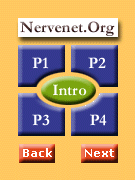




 |
 |
 |
 |
 |
|
|

|
|
||
|
EXPERIMENTAL PLAN |
|||
|
Principal Investigator/Program Director Williams, Robert W. |
|||
|
4. Image analysis The previous three goals of the experimental plan involved either enhancing or redesigning aspects of the MBL that were currently in place (Phase II). This goal, in contrast, focuses on the creation of a collection of novel functions to allow researchers to manipulate and analyze images online (Phase I). The scientific community has been blessed with a pair of open-source image manipulation and analysis programs written by Wayne RasbandNIH Image and Image/J. The latter is written in Java and it, along with its source code, will provide the foundation for all of the image manipulation and analysis tools that we will create. We have discussed our project with Dr. Rasband, and he has agreed to informally aid us by modifying Image/J to make it work well with the images on the MBL Below are some of the functions that we will implement Image Manipulation Among the common manipulations of images are contrast enhancement, sharpening, and brightness. Depending on the size of the image, these types of manipulations can be quite computationally intensive. One of the advantages of FlashPix technology is that manipulations such as these require less processing power and are therefore easier to imagine being performed over the Internet. Should we decide not to use FlashPix technology, we will consider the cost in terms of bandwidth and computing power to provide these types of manipulations and perhaps provide the tools to perform these manipulations locally. Segmentation of Regions of Interest As discussed in project 3, NeuroCartographer will do automatic segmenting of a variety of CNS structures. Dr. Nissanov will also provide tools for users to modify these automatically segmented structures, and these changes will propagate throughout the MBL. It is likely, however, that there will be some structures that are not easily segmented by the algorithms designed in Project 3, and we will therefore provide users of the MBL the ability to manually segment regions of interest. Having these regions segmented, the next logical step will be to measure these segmented regions. Some of this will be done automatically during the process of segmentation, but we will also provide the tools to estimate volume of CNS regions using Cavalieris rule. There are a number of macro routines that run in NIH Image that do this, and we will adapt these for Image/J. Neuronal Counts The iScope will provide high-quality through-focus QT movies of 100200 fields in each brain. To facilitate the counting of these cells, we will adapt Gary Leydons "Count Box" program for online usage. As detailed in Project 2, Dr. Leydon will be a consultant on this program project and will work with us to provide this important analysis tool. Densitometry Densitometry of Nissl-stained sections has been shown to be useful in architectonic parcellation of the cortex . We anticipate that future additions to the MBL may well include autoradiographic or other images where densitometry is necessary for conducting analysis. We will allow densitometric measures within automatically designated segmented regions as well as those that are user-defined. Hooks to other image analysis packages We recognize that not all users will prefer to perform their analysis online. In addition, they may have established protocols for image analysis locally that are essential for their own research designs. We will therefore create hooks to allow users to directly access images from the MBL for analysis by their preferred software package (i.e., NIH Image, NeuroZoom). Potential Pitfalls and Problems The benefits of Java technology on the web lie mainly in its "machine agnostic" nature. By providing tools for image analysis that are platform independent, we increase the potential utility of the MBL enormously. The promise of Java, however, sometimes has exceeded its abilities. Performance issues are a real concern, and badly written programs can execute slowly, even over a high-speed network. Although in an ideal world, Java programs should operate identically on all platforms, this is not always the case. We will extensively test our software on all major platforms (PC, UNIX, Macintosh) to ensure its compatibility. During the development process, we will institute rigorous testing procedures and will provide simple and direct methods for users to report bugs and incompatibilities. By making all programs open source, we increase our chances of optimizing code; talented individuals in the community at large will be able to make enhancements and additions.
|
|||
|
NEXT TOPIC |
|||